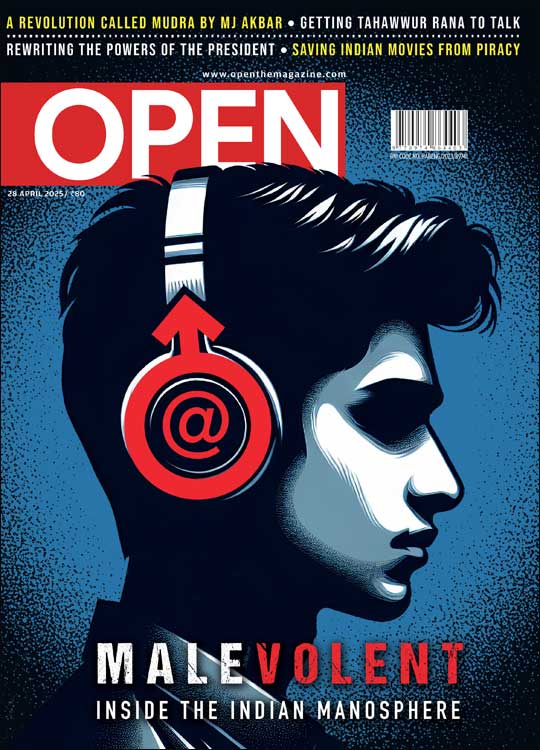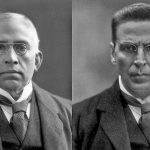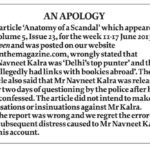The Man Who Prayed Too Much
The mysterious death of Satnam Singh Maan, a spiritual ‘schizophrenic’ arrested for an alleged attempt to murder godwoman Amritanandamayi
 Shahina KK
Shahina KK
 Shahina KK
|
30 Aug, 2012
Shahina KK
|
30 Aug, 2012
/wp-content/uploads/2015/11/satnam-1.jpg)
The mysterious death of Satnam Singh Maan, a spiritual ‘schizophrenic’ arrested for an alleged attempt to murder godwoman Amritanandamayi
Satnam Singh Maan, a student of Lucknow’s National Law School, was not just a ‘Bihari’—as reported by the Malayalam media after his mysterious death—who lost his way and winded up in Kerala because of a mental disorder. Those close to him say that his was a spiritual journey from the land of the Buddha to the land of Hindu seers Narayana Guru, Nataraja Guru and Adi Shankara.
Before he was arrested and murdered, Satnam spent a week at a Subhramanya temple in Thiruvananthapuram and another couple of weeks at Narayana Gurukulam in Varkala, headed by Muni Narayana Prasad, a disciple of Narayana Guru. On 31 July, Satnam vanished from the ashram, and turned up the next day at Amritanandamayi muth in Vallikkavu, Kollam, the seat of spiritual authority of Kerala’s famous godwoman Amritanandamayi, known across India as the ‘hugging mother’.
It was at this muth on 1 August that Satnam was handed over to the police.
He had allegedly tried to attack Amritanandamayi. The next day, he was remanded to Kollam sub-jail and later sent to a mental healthcare and research centre at Peroorkada in Thiruvananthapuram. That was the last stop of his spiritual quest. The journey he began on 30 May this year at 11 pm from his home in Sherghati, Gaya district, Bihar, came to an abrupt end.
The night he left, according to his cousin Vimal Kishore, he’d had a long discussion on dharma with his grandmother, who had been reading the Bhagawad Gita. Once she went to bed, Satnam went missing. He had left home in a T-shirt and shorts, like a mendicant.
What was a spiritual frame of mind to Satnam was schizophrenia to others. “He was not mentally sound and was under treatment for over four-five years,” says Vimal, a journalist with Aaj Tak. “Satnam was intelligent and philosophical, but he was abnormal,” says Dr KP Sharma, a psychiatrist at Patna’s Sanjeevani Hospital whose patient he was for four years, “He had symptoms of acute schizophrenia. Such people live in their imaginary world, which is unacceptable to society. That is the reason they need psychiatric care.”
Satnam’s disappearance had thrown his family into a tizzy. A two-month search by the police, friends and extended family members fetched no result. Nor did the ‘missing’ notices and Facebook ‘shares’. There was no sign of him. Finally, on the evening of 1 August, the family got a call from Karunangappilly police station in Kerala, saying that he had been in its lock-up, arrested for ‘attempted murder’. Stunned by this, Vimal caught an early morning flight to Thiruvananthapuram on 2 August. It was a bad day for an outsider to land in Kerala. There was a hartal on and most areas were deserted. Reaching Karunagappilly, just 92 km from the state capital, proved difficult. He eventually got an autorickshaw and arrived at the police station by noon.
Satnam had already been on television news the previous day as someone accused of a murder attempt on Amritanandamayi. By the police account, he had tried to barge his way forth to the dais on which she was bestowing her followers with a darshan, and tried to attack her. He had just chanted “Bismillah ar-rehmaan ar-raheem” when the guards nabbed him and turned him over to the police. It was an Islamic invocation in Arabic: ‘In the name of God, the gracious, the merciful.’ It was also enough, it seems, to have him instantly stamped as a suspected terrorist (as the police did, by a senior officer’s own admission).
Satnam was taken into police custody by 2 pm and presented before a magistrate the next afternoon. Remanded by the court, he was locked up. According to the police, he showed symptoms of mental distress. He was also violent, they say, he tried to pour phenol on fellow inmates in jail. Judged unstable, he was sent to the Peroorkada asylum.
By the midnight of 3 August, Satnam was brought to Thiruvananthapuram Medical College, where doctors on duty declared him dead. The autopsy revealed 77 wounds on his body, of which some grievous ones on his head and neck had proven fatal.
Vimal did get to see him alive. On 2 August, when he reached the police station around noon, he saw his cousin in a dhoti, looking strange and distressed. The journalist’s account of his meeting with his cousin offers a sense of how merciless the country’s law-and-order apparatus can be. “I had never seen my brother like that before. He did not even identify me in the beginning. I showed him the family photographs that I carried with me to produce before the police. Slowly, he showed signs of familiarity. ‘Oh, aap Raja bhaiyya hain…’ He turned happy. It was Rakshabandhan day, and I took a raakhi and told him that it was from his sister. Then he wept and hugged me and told me that he missed her. But the cops did not allow me to tie him his raakhi.They told me it was banned in Kerala.”
“[Satnam] was very upset,” Vimal continues, “He was surviving on medicines and had not had any for two months. He was talking absolute nonsense. He told me that he was drawn to Kerala by a magnetic field. He said I had reached the police station by the same mode of transport. He appeared in another world, totally delinked from the real.”
Vimal has a painful recollection of cops laughing at Satnam, all except the Circle Inspector who was in charge of the station. “He was rather kind to us,” says Vimal, “but even he told me that he could not help but charge him with the serious offence of ‘attempted murder’ as it was a high-profile case. I argued that Section 307 of the Indian Penal Code is not applicable to a mentally unsound person. I showed the police medical documents of his treatment and tried to convince them that he had been a patient of schizophrenia for long.”
Vimal’s pleas found no takers at the police station. So he went out looking for a lawyer. He met TK Manoj Kumar, a practising lawyer of the Kollam district court. “The cops gave me an assurance that they would inform me when they took him to the magistrate, but they did not do that. They produced him before the magistrate and he was remanded to jail by the time I returned with the lawyer.”
“Vimal is right,” says Advocate Manoj Kumar, “I got hardly 20 minutes to look at the case. By that time, they’d produced him and he was remanded. Then I prepared papers for his bail, and the plea for it was posted as Monday [6 August]. Satnam did not even get a chance to wait for his bail plea to be moved in court. He was beaten to death the very next day.”
Satnam was charged under the IPC even though the police knew he was not mentally sound. Before he was presented to the magistrate, he was taken to a psychiatrist at Taluk Hospital in Karunagappilly, Dr Kiran. “In my examination, I was convinced that he was in need of psychiatric care,” says Dr Kiran, who suggested a detailed examination and the attention of a psychiatrist.
The police did not bother with the doctor’s advice. “We charged him under Section 307 on the basis of the complaint we received from the Amritanandamayi muth,” says Radhakrishnan Pillai, Circle Inspector of Police at the Karunagappilly station. It is routine, he insists, for an accused to be charged with a crime on the basis of the nature of the complaint.
Law experts refute this argument. According to Advocate Kaleeswaram Raj, a senior lawyer at the Kerala High Court, an individual of unsound mind cannot be booked. Charging him with a murder attempt prima facie appears to violate the provisions of the Mental Health Act, which shields such people from criminal charges.
Strangely, however, not only was that law ignored, disciplinary action was taken against the five doctors who examined Satnam over the two days from his arrest to his admission to the mental hospital at Peroorkada. Dr Kiran, who had examined Satnam a few hours before his remand, was given a punishment transfer for ‘fabricating the medical report’. Dr Kiran is in the process of challenging this charge. Other doctors were penalised for ‘not recording the wounds properly’.
“What does the government mean by this action against five doctors? [That] none of them knows how to examine a patient?” asks Dr O Vasudevan, state president of the Kerala Government Medical Officers Association, “This is nothing but an effort to save the real culprits of the murder of Satnam Singh.”
But why would anyone murder Satnam Singh? Deranged people rarely have enmities, and he was too far away from home and had too little time to have rubbed anyone the wrong way. And what was the nature of the threat to Amritanandmayi that stirred her guards to action?
Perhaps there were clues at the muth. On the morning of 3 August, Vimal was summoned there for a meeting with ‘amma’. “She greeted me with a hug,” he says, “She and everyone there were convinced that Satnam was not mentally sound. Yet, they repeatedly asked the same question. Why had Satnam chanted an Islamic prayer instead of the Gita? I had only one answer: that he had not been in his actual element and was not really aware of what he was doing.”
The meeting with the hugging mother, Vimal feels, was a waste of time. “I should have gone to the jail instead,” he says, his voice full of regret, “…I could not save my brother.”
But then, Vimal was just too busy trying to negotiate his cousin’s release with whichever authority he could. Soon after he left the muth, he was informed by a journalist friend that the Assistant Director General of Police, the man in charge of Intelligence, had been visiting Amritanandamayi to discuss the case. Hoping to meet this senior official, Vimal made a second visit to the muth. This time, though, he was denied entry.
“The complaint lodged by the ashram authorities was very serious,” says Circle Inspector Radhakrishnappillai, who had arrested Satnam, “There was a similar attack on Amma two months earlier during her trip to the US. That assailant was also a Bihari. They suspected some connection with that incident.” And then he lets the coin drop. He reveals the real source of police anxiety: “This person had a beard, he was chanting, ‘Bismillah ar-rehmaan ar-raheem.’ How could I be sure he was not a terrorist?”
Satnam, a Brahmin by birth, had ironically been a victim of Islamophobia.
Going by the account of Muni Narayana Prasad, at whose ashram Satnam spent the last two weeks of his life, Satnam didn’t just wander his way aimlessly to Kerala. It was an actual spiritual trip. “He went to the Subhramanya temple, consecrated by Sri Narayana Guru at Kunnumpara, on a hill top near Kovalam, before coming to Gurukulam,” says Prasad, “There he met Professor Mahila Mani, who has been translating the works of Natarajaguru into Hindi, and he expressed interest in the writings of the guru. She then called me up and I asked her to send him to my ashram.”
Prasad was impressed with Satnam’s intelligence and love of religious reading. He was calm and had never expressed any symptoms of mental illness, except on the last day he spent at the ashram. “He had spent the whole day in the library,” says Prasad, who was so wowed by his interest in philosophy that he invited him to participate in a seminar on ‘Metaphysics and Politics’ conducted in Varkala—a gathering of academics, philosophers and writers.
On 31 July, Prasad remembers, Satnam turned restless and started speaking of snakes crawling all over his body. “It was the first instance that I felt he was mentally unsound,” he says, “I tried to convince him that it was only a delusion. Anyhow, that night Satnam turned violent, broke a glass window and disappeared from the ashram.” This was the day before his fatal error of articulation.
It was not the first mysterious death with links to the Amritanandamayi muth. The 1990 death of V Narayanan Kutty of Kodungalloor, Thrissur, offers a striking parallel. According to his friends and relatives, Kutty, similarly accused of violence at the muth, was pushed into the same mental healthcare centre by Amma’s devotees 22 years ago. He was found dead there. He was not crazy, his friends say, he was just someone with radical thoughts. After Satnam’s death, a newly formed action council is demanding that Kutty’s case be reopened.
Satnam’s case is not likely to be forgotten either. In all, six individuals have been held responsible by the police for his death. Four of them are inmates of the Peroorkada centre. The two others, of sound mind, have been arrested on charges of murder. One is Vivekandan, a policeman attached to the Prisons Department who was on duty on the premises at the time of Satnam’s death, and the other is S Anil Kumar, a first-grade attendant at the centre.
Whether that will serve the cause of justice, however, is far from clear. Satnam’s relatives and friends are doubtful. Says Vimal, “We believe the actual culprits are hiding behind a curtain.” Given the rot in the system, many fear it will stay that way.

/wp-content/uploads/2025/04/Cover-Manosphere.jpg)











More Columns
The Pontiff Who Led by Example Sudeep Paul
Find the Best App for Personal Loans Open Avenues
Truth or Lies? Nandini Nair